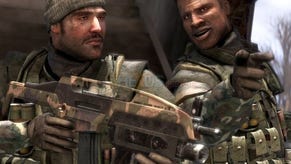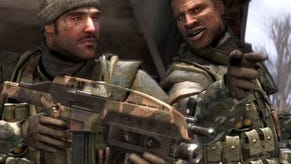Bad Company 2 performance analysis
Digital Foundry picks apart the beta.
Digital Foundry "hearts" DICE and has a particular penchant for Nordic developers in general. There's always a sense that we'll see something unique in the games that hail from this part of the world, and we're pretty much always guaranteed some lovely technical curiosities to set these games apart from the norm.
DICE in particular rarely disappoints. Even its utilisation of the ubiquitous Unreal Engine 3 middleware in Mirror's Edge resulted in a game that was innovative in both its technical approach and its core gameplay. The firm's latest - Battlefield: Bad Company 2 - is the third title to use its proprietary Frostbite engine, and it debuts in the form of a downloadable PSN beta exclusive to the PlayStation 3.
Eurogamer has already covered this multiplayer sampler from a gameplay perspective, but as usual the DF focus is on the Frostbite tech and its general performance. In his piece, Dan Whitehead lauded the improvements made to the destructible environments, but also commented on frame-rate and tearing issues, so let's tackle that straight away with a six-minute montage of clips from the beta.
Overall stats on performance are variable, but rarely impactful on the actual gameplay. The Bad Company 2 beta has a minimum frame-rate of 24FPS and based on this selection of clips, 13.9 per cent of the 60Hz output of the console consist of torn frames. Maximum frame-rate is 30FPS: any tiny spikes you see above 30 are simply artifacts of the shift between one clip and the next. On its own, average frame-rate isn't a particularly useful stat - the longer the gameplay clip, the less impact performance spikes have on the overall average. However, the 29.55FPS average figure is in line with the general trend of smooth performance seen in the video.
Screen-tearing is noticeable, but the overall impact on any given scene comes down to context. The relatively slow-paced first-person viewpoint combined with a fairly uniform colour scheme helps diminish the impact of tearing in many scenes, but where it is clearly evident is in the faster action scenes during intensive gunplay.
It is interesting to see just where the performance is hit looking across the video as whole. Overdraw - the process of overlaying transparencies - cleary has an impact, with foliage and smoke in combination being the main factors in lower frame-rates in some cases. However, the game's dynamic destruction system also incurs extra load on the engine at any given moment: a relatively simple scene inside a building can become inordinately more complex as walls blast apart and ceilings collapse.
Game engines maintain performance by culling unseen triangles and cutting out unneeded processing. In the case of Bad Company 2, an easy-to-render internal scene can see engine load rise dramatically simply due to the process of rendering the outside world through the holes made in a destructible wall. All things being equal, the frame-rates and tearing levels we see here are pretty decent bearing in mind the sheer unpredictability of the experience from a rendering perspective.
In terms of non-performance related stuff, there are a number of interesting elements. While in the vehicle and travelling at speed, we see some pretty aggressive level-of-detail (LOD) transitions in both objects and even terrain geometry. In normal gameplay on-foot, this is much more difficult to discern. Texture-filtering is very important in FPS games, and in this regard Bad Company 2 looks great with implementation of both trilinear and anisotropic filtering. There's some high-quality depth-of-field in play too, particularly evident when using iron sights. In common with previous Frostbyte games, Bad Company 2 on PS3 runs at native 720p with no anti-aliasing.
Getting a preview of the game four months ahead of release has been something of a treat. PC owners are due their own beta test soon, while the word from DICE is that the all three formats get an official multiplayer demo early in 2010.





